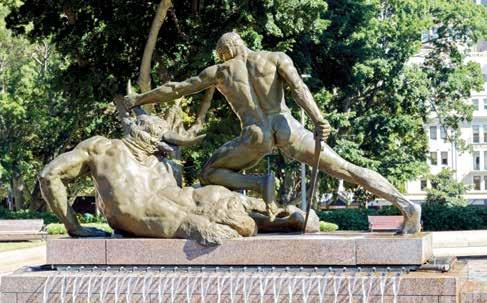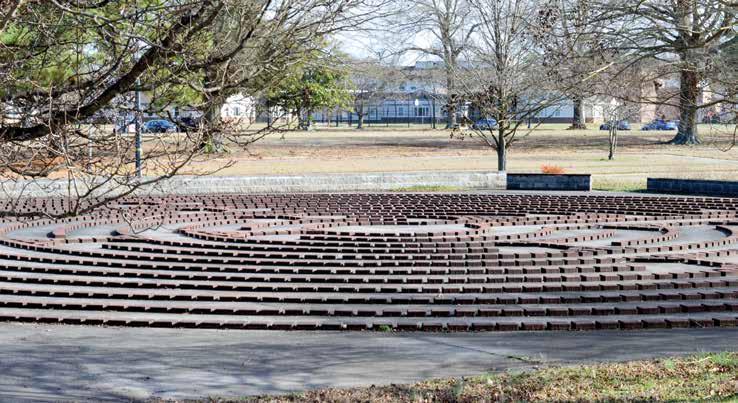
7 minute read
Labyrinths
Following a Twisting Track By Harmony Hunter
A magnificent boxwood path of twists and turns on the grounds behind The Governor’s Palace in Colonial Williamsburg. Photo courtesy of Richard Due
Advertisement

There’s an ancient riddle in which a man from Crete says, “All Cretans are liars.” The riddle is this: If the man is telling the truth, then he, too, is a liar, for he is from Crete, and, therefore, he must be lying about being a liar and thus telling the truth. This vortex of self-referential logic is known as “The Paradox of Epimenides” and can turn around on itself for infinity.
It is fitting, then, that the birthplace of this riddle produced another eternal winding puzzle: the labyrinth. Some of the earliest references to the labyrinth occur in the rich fields of Greek myth, where it is featured as a device invented by Daedalus, an architect, inventor and artist who features heavily in the plots of ancient Greece.
In its earliest appearance, the labyrinth is a dark maze Daedalus invents to imprison a Minotaur: a bloodthirsty half-man, half-bull produced by the bestial indiscretions of Crete’s queen. The Minotaur eventually was defeated by Athens’ Prince Theseus. He was assisted in his task by Ariadne, who secretly placed a ball of red thread and a sword inside the labyrinth for his use in fighting the beast and finding his way back out.
What began as a lonely monster’s pathetic prison has branched off in as many new paths as the original in the centuries since. The seven-course labyrinth of Crete is one of the earliest arrangements, but several others have joined the catalogue through time, taking geometric or spiraling shapes as placement and style dictated. Throughout history, the Christian church found great success in borrowing from the old practices of pagan religions. In keeping with this habit, the labyrinth was later absorbed into the Christian playbook. It makes a grand appearance in medieval France in 1193, subsuming the floor of the nave in the elegant gothic Chartres Cathedral. This venerated church is also home to the “Sancta Camisia,” a garment worn by the Virgin Mary at the birth of Christ. That the mythological labyrinth exists alongside the holiest of Christian relics is early evidence of the adaptable cunning of this Greek invention.
Theseus defeats the Minotaur at the center of the labyrinth

(left) Labyrinth at Sentara Williamsburg Regional Medical Center. Photo courtesy of Virginia Brick Pavers. (right) Governor’s Palace in Colonial Williamsburg



Labyrinth at Chartres Cathedral, France
The labyrinth which graces the stones of Chartres Cathedral traces a path that differs from the Cretan original, but the course remains true to the original notion of a maze which is solved by finding the center, rather than the exit. This journey became symbolic of man’s search for God and became a substitute pilgrimage for those unable to make the physical journey to Jerusalem and the sacred birthplace of Christ. Pilgrims surrendering their steps to the pattern of the labyrinth and being led alternately nearer to its central mystery and then being drawn back out to the edges was a walking meditation on man’s relationship to the divine.
Note, here, that the labyrinth has played its favorite game of leading us along one path and then steering us abruptly away: what was once a trap for a demon had become a path to the sacred by the thirteenth century. This reversal might be the best way of understanding how the labyrinth defies rule. It is manmade and logical when seen from above, but once the seeker surrenders control of their steps, the mind of the labyrinth is in control. We are lost, yet only a little. We are stranded, but on a governed path. A cage for our worst monsters, a devotion to our most sacred: the labyrinth is both. Like the man in Crete, it tells us a truth by telling us a lie.
The ineffable mystery of the labyrinth has persisted into the modern day. After making the jump from Crete to France, the labyrinth easily made the transition to the United States, assisted by a recent revival of the form with the publication of Lauren Artress’s 1995 book, Walking a Sacred Path. The book, an exploration of the labyrinth in Christian spiritual settings, promoted a method of creating a portable labyrinth painted on canvas panels that could be assembled and disassembled in temporary installations.
One such example is found in historic Yorktown, Virginia. At Grace Episcopal Church, a Chartres-style labyrinth 31 feet in diameter has hosted a wide array of meditations and devotions. The church’s literature says, “Walking can be a spiritual experience. Movement can be prayer. In fact, for some of us, like St. Augustine, walking is the way we find contemplation, discernment and often can best encounter the divine. The labyrinth is a spiritual tool that helps us use our walk ing for spiritual purposes.”
Therapeutic labyrinth at Eastern State Hospital. Photo courtesy of Harmony Hunter

One of Williamsburg’s most poignant examples of the labyrinth’s power to bring restful meditation is an 11-circuit medieval labyrinth installed on the grounds of Eastern State Hospital, a psychiatric institution in the center of town. Dedicated in 2002 as a “therapeutic labyrinth,” the plaque that welcomes patients and the public alike reads: “This labyrinth represents an opportunity for walking meditation that is one of the oldest contemplative and transformational tools known to humankind. For centuries, the labyrinth has been used to promote healing, connection, community and peace.”
The trend for using the labyrinth as a tool for meditative recovery in healthcare settings is echoed again at Sentara Williamsburg Regional Medical Center, where an eight-circuit medieval labyrinth of brick pavers is open for patients and their families. Beyond their use in healthcare, professional landscape design and home gardeners are rediscovering the fixture as a centerpiece in modern gardens and botanical conservatories. The labyrinth offers an interactive element that transforms the garden from something to be admired to something that can be experienced through motion.
Deeper in Williamsburg lies another, much older labyrinth. In the extensive grounds behind the Governor’s Palace in Colonial Williamsburg’s Historic Area, an example of the eighteenth-century continental fashion for hedge mazes is evidenced in a magnificent boxwood path of twists and turns. Williamsburg’s Governor’s Palace landscape design would have been influenced by the standard set at England’s Hampton Court Palace, where today is found the oldest surviving topiary maze. This garden feature likely dates to the 1690s, when the Dutch King William and his wife Mary installed it. The couple must have favored the novel path of the maze, because they had a second one at their palace in the Netherlands.

While modern scholars make the distinction between a “multicursal maze” as a structure that contains dead ends, and a true labyrinth as a “unicursal maze” with one single path to the center, the terms were used interchangeably well into the 1700s. Open year-round to ticketed guests, the mazelabyrinth at the Governor’s Palace dares its guests to surrender not just their steps, but their line of sight in this tall, growing structure.
No matter the location of a labyrinth, one cannot consider its branching meanings without remembering its inventor. Mythologized for his cleverness and ingenuity, something of Daedalus’s intelligence seems to have been transferred to the labyrinth he created. A trap that was seemingly simple, yet confusing enough to confound a Minotaur has become a slice of geometric whimsy that manages to translate itself into new uses and new meanings through all of time’s roads.
Born from the mists of Greek myth and translated through centuries of use in religious, decorative and secular settings, the labyrinth allows us to believe we are its master. The long survival of this puzzle rich with a suggestion of magic hints that the labyrinth is an intelligence unto itself, keeping its own counsel through the ages, reminding us that life’s patterns are not always evident until seen from above. H









